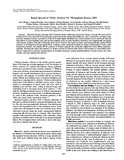| dc.description.abstract | BetweenJanuaryandJune2005,5distinctcholeraoutbreaksoccurredinKenya.Overall,990casesand25
deaths(2.5%)werereported.Fouroutbreaksoccurredintownsalongmajorhighways,and1occurredinarefugeecamp
near the Sudanese border, accessible to Nairobi by daily flights. Matched case–control studies from 2 outbreaks showed
that failure to treat drinking water and storing drinking water in wide-mouthed containers were significantly associated
with disease. Isolates from all 5 outbreaks were Vibrio cholerae O1, Inaba serotype, and had genetically similar PFGE
patterns of SfiI-digested chromosomal DNA. Linkage of the outbreak locations by major transportation routes, their
temporal proximity, and similar PFGE patterns of isolates suggests the outbreaks might have been linked epidemiologically,
showing the speed and distance of cholera spread in countries like Kenya with pockets of susceptible populations
connected by modern transportation. Prevention measures remain implementation of point-of-use safe water
systems and case finding and referral. | en_US |

